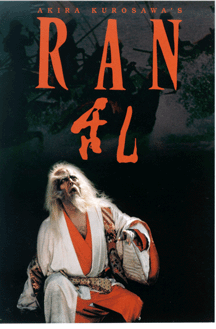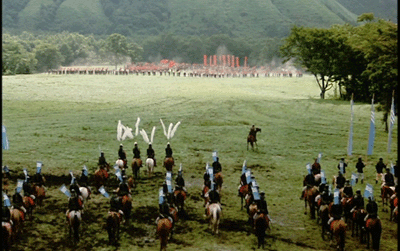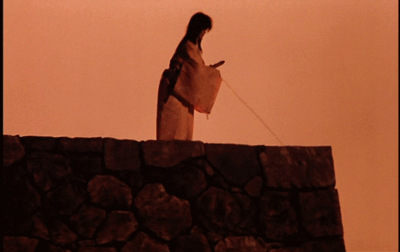
CINEMATIC ALLUSIONS TO LITERARY WORKS
RAN (1985)

Against images of stunning natural beauty, graceful artistic culture and heroic military bravery, Akira Kurosawa remakes Shakespeare's King Lear as a medieval Japanese tale. For all its physical beauty, the story unfolds darkly, shaped by slowly-revealed cruelty, predatory revenge and helplessly suffering innocence.
The film opens with an ominous hunt during which mounted archers slay an old wild boar, too tough to eat. The leader of the hunt is Lord Hitedora, ready to resign to his sons the leadership of his territory. Through his life he gained and maintained his power by cruelty and deceit, but he expects that his sons will treat him with kindness and respect when he gives them authority. When his youngest and only loving son Saburo objects to Hitedora's plan, Saburo is banished. Hitedora loses favor, his sons war on one another, neighboring lords destroy his hard-won kingdom, his sons are murdered. Hitedora sees the children of his former enemies take vengeance on his family or suffer increased degradation.
Shakespeare built sympathy and recovery into the end of King Lear. Though Lear and his daughters all die, we witness acts of regenerative kindness and justice. The British kingdom is restored. Kurosawa leaves us with a bleak vision of suicidal destructiveness and social disintegration.
Steven S. Urkowitz, Ph.D.
Professor, English
Theatre and Speech Program
Ran. Dir. Akira Kurosawa. Perf. Tatsuya Nakadai, Akira Terao, Jinpachi Nezu, and Daisuke Ryu. DVD. Fox Lorber, 1985.
 |
The warlord Hitedora (Tatsuya Nakadai) gathers his sons and rival leaders to give away control over his territory. This parallels King Lear Act 1, Scene 1 where Lear distributes his kingdom to his daughters. |
In one of many brilliantly depicted battle scenes the armies of two of Hitedora's (Tatsuya Nakadai) sons (Akira Terao and Jinpachi Nezu) prepare to fight. Shakespeare's climactic battle in his theatrical version of the story takes place economically as trumpet calls and military noises offstage with only a single blind figure sitting alone onstage in view of the audience. |
 |
 |
The closing image of Ran focuses on one of Hitedora's (Tatsuya Nakadai) victims, a young prince blinded years ago by the warlord. The aftermath of extended cruelty is only further suffering. In Shakespeare's Lear, repeated acts of kindness and loyalty yielded grace and healing after the trauma of violence. |
Bibliography
Hollinger, Douglas L. "Throwing Lear into Chaos: Reading Kurosawa's Ran as Filmed Shakespeare."
Conference of College Teachers of English Proceedings 55 (1995): 76-83.
Nogueira Diniz, Thaïs Flores. "King Lear's Filmic Adaptation: A Chaos?"
Canadian Review of Comparative Literature/Revue Canadienne de Littérature Comparée 23.3 (1996): 775-780.
Serper, Zvika. "Blood Visibility/Invisibility in Kurosawa's Ran." Literature/Film Quarterly 28.2 (2000): 149-154.
Shakespeare, William. King Lear. Cambridge, England: University Press, 1968.
| Previous Movie | Return to main page | Next Movie |
Copyright © The City College Library www1.ccny.cuny.edu/library |
||